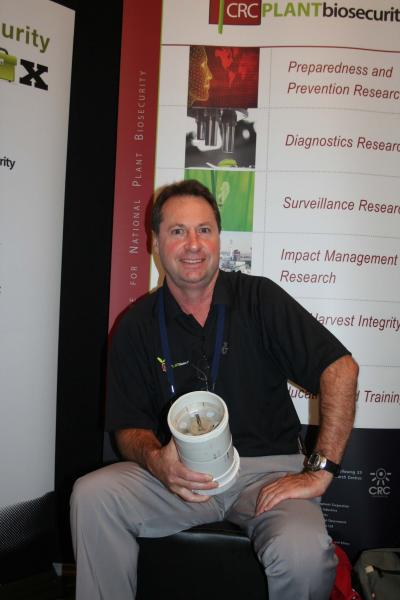Flying spore traps hit the ground

In many of the Cooperative Research Centre for National Plant Biosecurity's research projects, methodologies and technologies from disciplines outside of the traditional plant science groups (such as entomology and plant pathology) are used.
These diverse skill sets are critical to ensure the research outputs of the CRC are innovative and make best use of all available technologies, while maintaining relevance to plant biosecurity research.
The expertise of Mr Les Zeller, a Senior Research Engineer from Queensland's Department of Employment, Economic Development and Innovation has been fundamental throughout the Flying Spore Traps project.
With over 28 years of experience in design, development and application of engineering technologies for agricultural research, Les designed a spore trap using standard plumbing fittings, an electric fan from a dust buster, a radio controlled servo motor and microcomputer components. This spore trap's sampling method is based on the commercial Burkard system and one developed by Murdoch University but allows functional mobility by fitting it to an unmanned aerial vehicle (UAV). Les has developed an indexing device to allow site specific sampling which may revolutionise the method for capturing spores.
Traditionally, spore sampling devices have been stationary at the sampling location, and have been problematic in remote locations or when topography is severe. To provide enhanced surveillance capability and to contribute data to ‘area freedom', the UAV is able to fly around crops on a pre-determined path collecting spores from specific locations, while providing a geo-referenced sample for the laboratory.
While the initial focus of the project was to link advancements in UAV research, the CRCNPB Board have recently approved changes to the scope of the project which will adapt the mobile spore trap design so the unit can function in both land-based and aerial platforms.
In other changes to the project, expertise in aerospace avionics engineering will be brought in with Professor Rod Walker from Queensland University of Technology's (QUT), School of Engineering Systems taking leading role as Project Leader. Rod and his team will further develop Les' design to operate on a UAV which will involve intensive wind tunnel and field testing.The project page will be updated shortly to reflect these new approved changes.
Mr Zeller will use his engineering skills to develop a land-based system for a car or quad bike that will allow the aerial prototype to be interchanged from UAV vehicles to a land-based vehicle. Before the final deployment of the new unit, its performance will be thoroughly analysed to ensure it meets the required performance in a biosecurity setting.
The complete integration of the modified spore trap onto land and aerial vehicles is expected to be completed and tested by May 2010, with a final report and recommendations for commercialisation by June 2010.
Photo caption: Les Zeller shows his original spore trap

